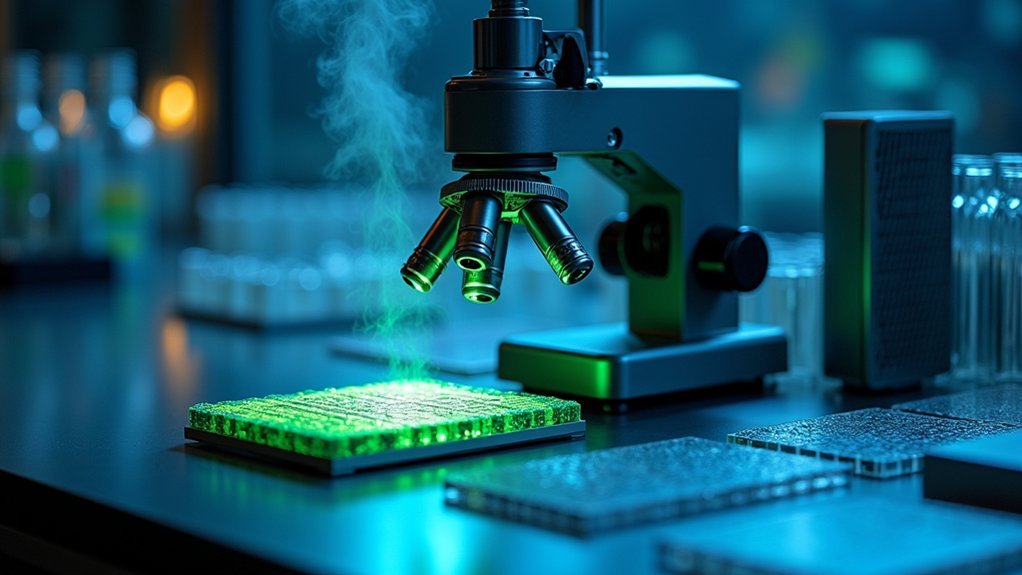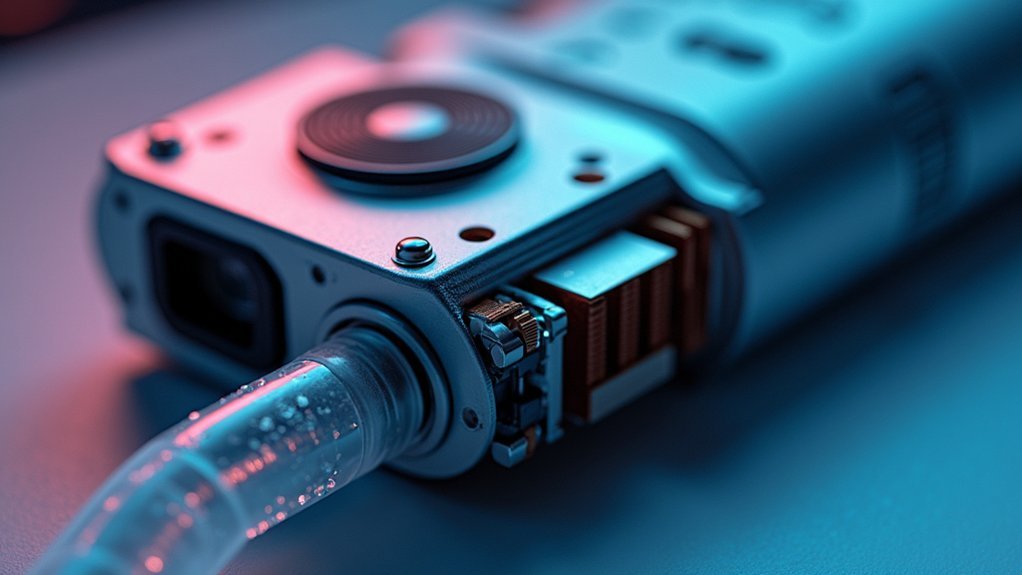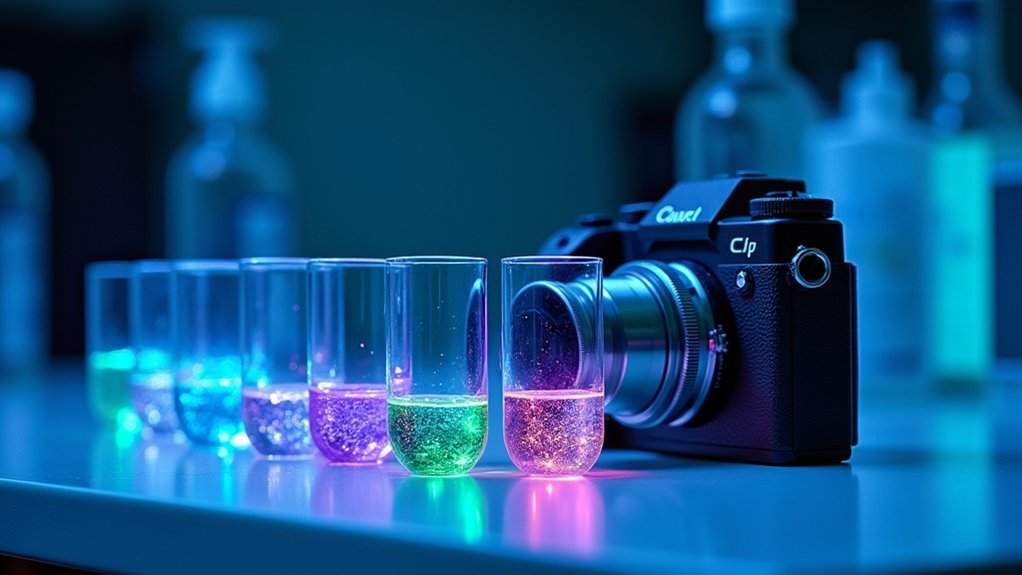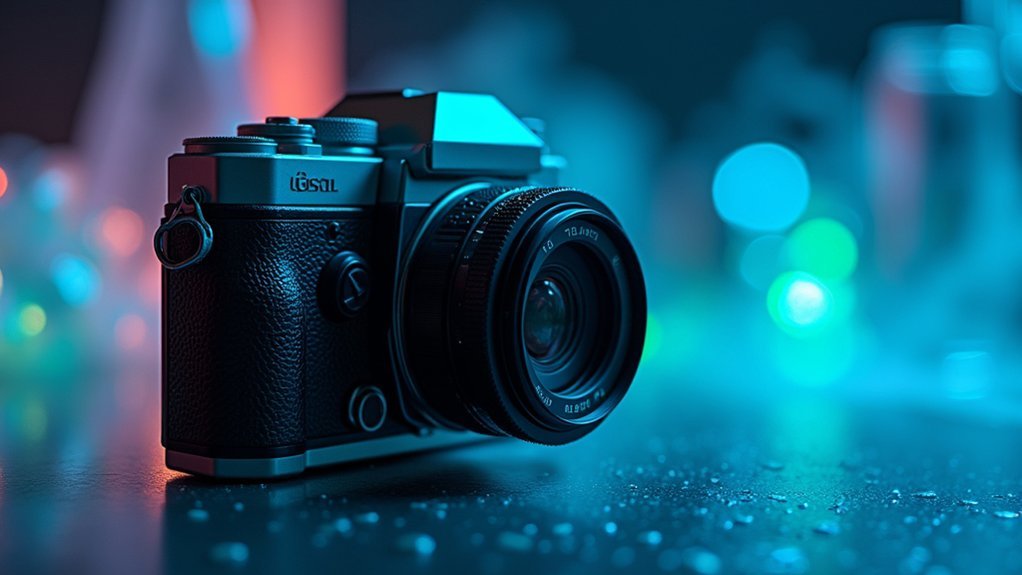Cooling your camera greatly improves fluorescence imaging quality by reducing dark current noise, which doubles with every 7-8°C temperature increase. Active cooling systems like Peltier elements or liquid cooling provide better thermal stability than passive methods, enhancing signal-to-noise ratio and preserving useful dynamic range during longer exposures. For live-cell experiments, maintain 37°C to preserve cellular behavior, while fixed specimens benefit from cooler temperatures (4-20°C). The right cooling approach can transform your imaging outcomes from adequate to exceptional.
12 Second-Level Headings for “Cool Down Your Camera for Better Fluorescence Imaging”

While many researchers focus on objective selection and sample preparation, your camera’s temperature remains a crucial yet often overlooked factor in fluorescence imaging quality.
You’ll find that cooling your camera sensor directly impacts dark current—an unwanted noise source that doubles with every 7-8°C temperature increase.
By implementing active cooling technologies like Peltier elements, you’re not just reducing thermal noise; you’re markedly enhancing your signal-to-noise ratio (SNR). This improvement is especially critical in photon-starved applications where every detected photon matters.
Don’t underestimate the importance of temperature stability either. Maintaining consistent cooling guarantees your quantitative measurements remain reproducible across experimental sessions.
When you’re analyzing faint fluorescent signals, even minor temperature fluctuations can compromise data accuracy, making proper cooling an essential component of your imaging system rather than a luxury.
The Physics Behind Camera Sensor Cooling
When you understand the quantum mechanics at play, camera sensor cooling becomes more than just a technical specification.
It’s a fundamental principle that directly impacts your fluorescence imaging results.
The dark signal in your camera sensor increases linearly with both exposure time and temperature.
More critically, this noise doubles approximately every 7-8°C, following an exponential relationship that quickly degrades your signal-to-noise ratio (SNR) at higher temperatures.
How Temperature Affects Signal-to-Noise Ratio

Understanding this exponential temperature-noise relationship leads us directly to what matters most in fluorescence imaging: signal-to-noise ratio (SNR).
Temperature dictates everything in fluorescence imaging—control it and you control your signal-to-noise ratio.
When your camera sensor temperature increases, dark current noise doubles approximately every 7-8°C, dramatically reducing your SNR. This is particularly problematic when you’re capturing faint fluorescence signals.
You’ll achieve clearer images by keeping your sensor temperature low and stable. This approach serves two critical purposes: it minimizes the noise competing with your actual signal and guarantees your quantitative measurements remain reproducible across experiments.
For photon-starved applications where every signal photon counts, effective cooling isn’t just helpful—it’s essential. By controlling your camera’s temperature, you’re directly enhancing your ability to detect weak fluorescence signals that would otherwise be lost in thermal noise.
Dark Current Reduction: The Primary Benefit of Cooling
Although fluorescence imaging faces many challenges, dark current represents one of the most significant obstacles to acquiring clear, high-quality images. This thermal noise doubles approximately every 7-8°C, exponentially degrading your imaging capabilities at higher temperatures.
When you cool your camera sensor, you’re directly targeting this unwanted signal. The reduction in dark current immediately improves your signal-to-noise ratio (SNR), preserving the useful dynamic range that would otherwise be compromised. This becomes especially critical during longer exposures typical in fluorescence applications.
Implementing active cooling solutions—whether thermoelectric elements or water cooling systems—keeps your sensor at ideal temperatures, ensuring consistent quantitative measurements.
You’ll notice the difference in reproducibility and reliability of your research data, particularly when detecting faint fluorescent signals that would otherwise be lost in thermal noise.
Active vs. Passive Cooling Systems for Microscope Cameras

The selection between active and passive cooling systems fundamentally shapes your fluorescence imaging capabilities.
Active cooling, typically utilizing thermoelectric (Peltier) elements, greatly reduces sensor temperature, minimizing dark noise and enhancing signal-to-noise ratio (SNR) in photon-starved applications.
Thermoelectric cooling dramatically lowers thermal noise, delivering superior SNR when every photon counts.
While passive cooling relies on natural heat dissipation and may suffice for basic imaging, it can’t maintain consistent performance during extended sessions or at higher ambient temperatures.
For quantitative fluorescence measurements, you’ll need the temperature stability that only active cooling provides.
Premium active cooling systems incorporate additional features like forced air or water cooling, further improving heat dissipation.
When selecting a camera system, consider your specific requirements—if you’re capturing faint fluorescence signals, investing in robust active cooling will deliver remarkably better results by ensuring consistently low dark noise levels.
Optimal Temperature Ranges for Different Fluorescence Applications
When imaging faint fluorescence signals, you’ll need to cool your camera to -40°C or lower to minimize dark current noise and achieve ideal signal-to-noise ratios.
For live-cell experiments, balance cooling requirements with environmental conditions that won’t stress cells, typically maintaining temperatures between -20°C and -30°C for most InGaAs cameras.
Fixed specimens allow you to prioritize maximum cooling for enhanced sensitivity, while live-cell work requires careful consideration of both imaging quality and biological viability.
Low-Noise Sensitive Imaging
Successful fluorescence imaging largely depends on maintaining appropriate camera temperature ranges to minimize noise interference. When you’re capturing faint fluorescent signals, cooling your camera becomes essential since dark current noise doubles with every 7-8°C temperature increase, dramatically affecting your signal-to-noise ratio.
For ideal quantum efficiency (QE), keep InGaAs cameras around 10°C where photon-to-electron conversion peaks. This is particularly critical for photon-starved applications where every signal counts.
Consider implementing thermoelectric or water cooling systems to stabilize your sensor temperature and prevent the exponential increase in dark signal noise that occurs with longer exposures.
Remember that consistent thermal management isn’t just about better images—it’s essential for reproducible quantitative measurements, as temperature fluctuations directly impact pixel intensity and can compromise your experimental data.
Cell Survival Considerations
Although optimizing camera performance is essential, balancing sensor cooling with cell viability remains equally important for successful live-cell fluorescence imaging.
You’ll want to maintain temperatures between 20-25°C for most fluorescence applications—this sweet spot minimizes thermal noise while supporting cell survival during extended imaging sessions. Excessive cooling might reduce dark current but can stress or damage living specimens. Conversely, inadequate heat dissipation leads to thermal noise that obscures your weak fluorescence signals.
For quantitative studies, consistent cooling stabilizes your sensor’s performance, preventing temperature fluctuations that could compromise measurement accuracy. When imaging particularly dim signals, you’ll need more aggressive cooling systems to enhance your signal-to-noise ratio.
However, always prioritize cell survival by ensuring cooling mechanisms don’t directly contact living samples or create inhospitable microenvironments that would compromise your biological observations.
Live-Cell vs. Fixed
Live-cell and fixed-sample imaging require fundamentally different temperature strategies for ideal fluorescence results.
When imaging living cells, you’ll need to maintain physiological temperatures around 37°C, regardless of exposure time, to preserve natural cellular behavior. Cooling isn’t usually necessary if you’re receiving sufficient photon signals.
Fixed samples, however, benefit greatly from cooler temperatures between 4°C and 20°C. This cooling minimizes heat-generated dark current noise and enhances your signal-to-noise ratio (SNR). The lower temperatures improve quantum efficiency, allowing for clearer images and more accurate quantification of fluorescent signals.
Remember that temperature stability matters just as much as the temperature itself. For reproducible quantitative measurements, maintain consistent cooling for fixed samples, but avoid excessive cooling with live specimens to prevent stress-induced artifacts in your data.
Impact of Cooling on Quantum Efficiency and Dynamic Range
You’ll see immediate noise reduction benefits when cooling your InGaAs camera, as thermal dark signals decrease exponentially with temperature drops.
This cooling effect extends your detection limits by preventing noise from overwhelming weak fluorescence signals, especially during longer exposure times.
Your quantitative measurements will also gain reliability through stabilized sensor temperature, ensuring consistent dynamic range and improved blue wavelength sensitivity.
Noise Reduction Benefits
Three critical benefits emerge when cooling your camera sensor for fluorescence imaging.
First, you’ll dramatically reduce dark current noise, which grows exponentially with temperature and exposure time. This reduction greatly improves your signal-to-noise ratio (SNR), allowing detection of even the faintest fluorescence signals.
Second, cooling enhances quantum efficiency (QE), with approximately 1% improvement for every 2°C temperature drop. This means you’ll capture more of your fluorescence signal with the same exposure settings.
Third, your camera’s useful dynamic range expands as thermal noise decreases, enabling accurate measurements across broader intensity ranges.
With active cooling methods like thermoelectric elements, you’ll maintain stable sensor temperature regardless of ambient conditions, ensuring consistent noise levels and reproducible results—crucial for quantitative fluorescence applications where data reliability matters.
Extending Detection Limits
Cooling your camera sensor doesn’t just reduce noise—it fundamentally extends the detection limits of your fluorescence imaging system.
With each 2°C temperature drop, you’ll gain approximately 1% in peak quantum efficiency, enabling your camera to detect more photons from dim fluorescent samples.
The benefits compound when you consider dynamic range. As temperature decreases, dark current noise drops exponentially, preserving your system’s ability to distinguish between intensity levels across a wider signal range. This is vital when imaging samples with both bright and faint fluorescent regions.
Remember that dark current doubles with every 7-8°C temperature increase, severely limiting your detection capabilities.
Cooling Technologies: Peltier Elements, Liquid Cooling, and More

When capturing fluorescence images, the sensor temperature of your camera plays an essential role in determining image quality. Most scientific cameras incorporate Peltier elements, which efficiently cool the sensor to minimize dark current noise—a troublesome signal that doubles approximately every 7-8°C temperature increase.
Managing sensor temperature is critical for fluorescence imaging—cooler sensors yield clearer images with significantly reduced noise interference.
For standard fluorescence applications, Peltier cooling often provides sufficient temperature reduction. However, if you’re conducting extended imaging sessions or particularly sensitive experiments, liquid cooling systems offer superior thermal stability. These systems circulate coolant around the sensor, preventing thermal fluctuations that could compromise your quantitative measurements.
Your choice of cooling technology should align with your specific imaging requirements.
Remember that effective temperature management isn’t just about better images—it guarantees consistent, reliable data across your entire experimental timeline.
Managing Condensation Risks in Cooled Camera Systems
Condensation in cooled camera systems can ruin your fluorescence imaging if you don’t understand the dew point – the temperature at which water vapor condenses into liquid.
You’ll need effective anti-fog solutions, such as silica gel packs or heated optical windows, to prevent moisture from accumulating on critical components during extended cooling periods.
Investing in properly sealed housing designs with hermetic seals or nitrogen purging can create a controlled microenvironment that shields your sensitive camera electronics from ambient humidity fluctuations.
Dew Point Fundamentals
Understanding the dew point is essential if you’re serious about protecting your cooled camera system during fluorescence imaging. The dew point represents the temperature at which air becomes saturated with moisture, causing condensation to form on surfaces.
When your camera’s temperature drops below this critical threshold, water droplets can develop on sensitive components, potentially causing damage.
Monitor your lab’s humidity levels closely, as higher humidity raises the dew point temperature and increases condensation risk. For example, in a humid environment, your camera might reach the dew point at a higher temperature than expected, creating moisture problems even with moderate cooling.
Implement proper cooling strategies that maintain your camera’s temperature safely above the dew point. Regular system checks will help guarantee you’re balancing ideal cooling performance with condensation prevention.
Anti-Fog Solutions
Despite the critical need for cooling cameras during fluorescence imaging, managing condensation remains a significant challenge for researchers. You’ll need strategic approaches to prevent moisture buildup that can compromise image quality.
Apply anti-fogging agents to optical surfaces to maintain clarity during temperature changes. Guarantee proper airflow around your camera to prevent stagnant air that accelerates condensation formation.
| Strategy | Function | Benefit |
|---|---|---|
| Dehumidifier | Reduces ambient moisture | Minimizes condensation risk |
| Gradual cooling | Maintains stable temperature gradient | Prevents sudden moisture formation |
| Heating elements | Warms critical components | Counteracts condensation during changes |
Remember to avoid rapid temperature fluctuations when operating your cooled camera system. Instead, implement a controlled cooling process that maintains an appropriate temperature gradient between your imaging equipment and its environment, preserving optical performance during extended imaging sessions.
Sealed Housing Designs
While anti-fog solutions offer temporary protection, sealed housing designs provide a thorough approach to moisture control in cooled camera systems.
These designs create an airtight environment that prevents moisture from entering your camera’s internal components, particularly when ambient temperature fluctuates rapidly during imaging sessions.
The sealed housing acts as a barrier between your sensitive equipment and external humidity, effectively eliminating condensation risks that could compromise image quality and damage your sensor.
Many manufacturers incorporate specialized materials that maintain perfect seals along with desiccants that absorb any residual moisture inside the housing.
To maximize the benefits of your sealed housing design, implement a regular inspection routine to verify seal integrity.
This proactive approach guarantees consistent performance and extends the lifespan of your fluorescence imaging equipment.
Camera Cool-Down Times and Thermal Stabilization
Because cameras house significant heat reservoirs like batteries and metal components, they require substantial time to reach thermal equilibrium. Your DSLR might need approximately 2.25 hours to cool from 15°C to 4°C ambient temperature.
Camera thermal equilibrium isn’t instant—expect several hours for your DSLR to fully acclimate to environmental temperatures.
The camera’s body material matters—metal conducts heat more efficiently than plastic, potentially shortening thermal stabilization periods.
For consistent imaging quality, you’ll want to stabilize your camera’s temperature before critical fluorescence measurements. Consider these approaches:
- Run continuous shooting sequences to maintain stable sensor temperatures
- Allow longer cool-down times in warmer environments
- Test your specific camera model’s cooling performance, as it varies between devices
Remember that proper thermal stabilization directly impacts noise levels and measurement accuracy in fluorescence applications, especially when conducting quantitative imaging work.
When Cooling Matters Most: Low-Light Fluorescence Techniques

As thermal stabilization prepares your camera system, we now need to contemplate when cooling becomes most valuable in practical applications.
Cooling is absolutely critical during low-light fluorescence imaging, where faint signals must be distinguished from background noise. Your exposure times often extend considerably in these conditions, and that’s precisely when dark current noise becomes problematic.
Remember, InGaAs cameras see dark current double with every 7-8°C temperature increase, devastating your signal-to-noise ratio.
You’ll find cooling particularly essential when:
- Working with weakly fluorescent samples
- Performing quantitative measurements requiring reproducibility
- Using longer exposure times (which become dark signal limited rather than readout noise limited)
- Pursuing blue-shifted fluorophores, as cooling improves quantum efficiency in this range
Don’t compromise your fluorescence data—prioritize cooling for photon-starved applications.
Cost-Benefit Analysis of Camera Cooling Options
Since cooling systems add both cost and complexity to your imaging setup, understanding their return on investment is essential.
Cooling systems offer critical performance advantages despite their initial expense—a worthwhile investment for precision imaging applications.
When conducting a cost-benefit analysis, consider whether your work requires quantitative data precision or merely qualitative imaging. For photon-starved applications, the improved signal-to-noise ratio from active cooling methods like Peltier elements directly translates to superior image quality worth the investment.
The physical construction of your camera also impacts cooling efficiency—cameras with steel or magnesium bodies dissipate heat more effectively than plastic ones, potentially justifying their higher price tag.
While cooling systems represent an upfront expense, they often pay dividends through more reliable data and consistent imaging performance. For applications requiring high sensitivity, the enhanced results from forced convection or water cooling systems typically outweigh their costs.
Frequently Asked Questions
What Camera Is Best for Fluorescence Microscopy?
For fluorescence microscopy, you’ll want a cooled sCMOS or EMCCD camera. They offer high sensitivity, low noise, and fast frame rates. Monochrome models outperform color cameras due to their superior quantum efficiency.
Why Do Cameras Need Cooling?
You need camera cooling to reduce dark current noise that increases exponentially with temperature. It’s essential for capturing weak fluorescence signals with higher signal-to-noise ratios and maintaining consistent imaging results over time.
What Are the Disadvantages of Fluorescence Imaging?
You’ll face challenges with fluorescence imaging including high background noise from autofluorescence, reduced quantum efficiency with color cameras, phototoxicity during long exposures, limited dynamic range due to dark current, and costly high-sensitivity equipment requirements.
What Is Fluorescent in a Camera?
In your camera, fluorescence refers to detecting light emitted from fluorescently labeled samples after excitation. Your sensor captures these emitted photons and converts them into digital signals for visualization of cellular structures.
In Summary
You’ll see dramatic improvements in your fluorescence imaging by cooling your camera properly. Whether you’ve chosen active or passive cooling, you’re reducing dark current and improving signal-to-noise ratios with every degree dropped. Don’t underestimate the impact temperature has on capturing those faint signals. Balance your cooling needs with your budget, and you’ll achieve cleaner images that reveal the subtle details you’ve been missing.





Leave a Reply